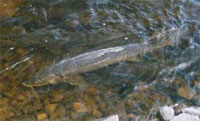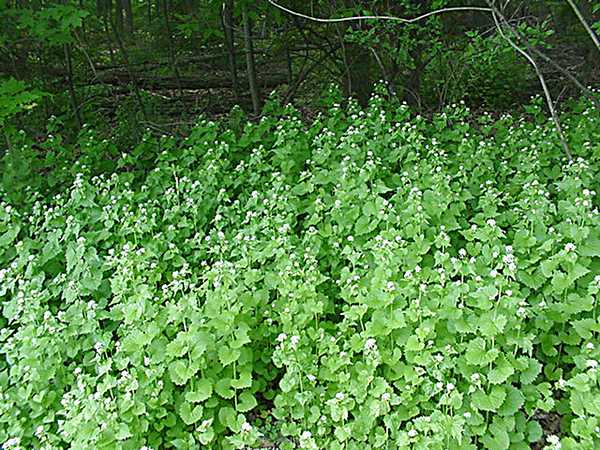By EMMA OGUTU
Volunteers called to find plant invaders, sturgeon poachers
Capital News Service

Lake Sturgeon, Credit: DNR
LANSING — It sounds like an exotic, almost-always fresh seasoning or must-have condiment with bright green heart-shaped rosettes and beautiful white flowers.
So garlic mustard must be a delight.
Not. It’s an unwanted spring beauty and officials want it stamped out of state parks and recreation areas because the non-native invader thwarts the growth of Michigan’s treasured diversity of native wildflowers.
The Department of Natural Resources is urging park visitors to look for and report the weed so employees and volunteers can uproot and eradicate it.
The worst hit areas are in Southeast Michigan, according to DNR officials.
“It’s crucial that we find invasive plants when they first arrive,” said Ray Fahlsing, DNR Parks and Recreation stewardship unit manager. “If we respond rapidly with control measures, we may be able to eliminate the invasive plant before it damages wildflowers and other natural resources.”
DNR’s enemies’ list also includes Japanese knotweed and black swallow wort.
Garlic mustard is described as an “early riser.” Its low-lying leaves take advantage of the first rays of spring sunlight after snows melt to flourish ahead of other plants in the woods.
And it’s highly adaptable.
The alien species was brought to the U.S. by European settlers as an herb and is spreading across the continent at a rate of 2,471 square miles per year – an area 10 times the size of Toronto, according to the Nature Conservancy.
It produces many seeds which remain viable for five to 10 years, has no known natural predators and excretes a chemical from its roots that prevents other plants from developing.
“We do have a lot of park visitors who are concerned about nature conservation, and it makes sense to tap that interest,” said Lindsay Ross, a DNR steward assistant. “Visitors also get to see areas of the parks we don’t get to see.”
A number of environmental organizations are enlisting the public’s help to protect native species and get rid of suspicious invasive ones.
For example, Sturgeon for Tomorrow, based in Cheboygan, is committed to the survival and repopulation of the threatened lake sturgeon.
Since 1999, from late April through May, the group has collaborated with volunteers to guard the fish while it spawns along the shorelines of Cheboygan County’s Black River.

Garlic Mustard, Credit: Steve Mayer
“We can always use extra eyes and ears to guard the fish along the 6-mile stretch of the river,” said Brenda Archambo, president of the group’s Michigan chapter.
Any fish that needs up to 20 years to reach sexual maturity and reproduces only once every four years is in danger of population decline or extinction, the U.S. Fish and Wildlife Service warns.
In 2009, a Grand Rapids man was jailed for 30 days, ordered to perform 50 hours of public service with the DNR and fined $2,298, after witnesses took cell phone photos of him hooking a sturgeon by the tail and dragging it to a waiting pick-up truck.
The incident occurred on the Grand River in Grand Rapids.
Overfishing and loss of critical habitat have reduced the population of the Great Lakes giant which can grow to up to 300 pounds and nine feet long.
Archambo said that, together with Michigan State University researchers, the sturgeon watch group has noticed a growing number of younger lake sturgeons since it started the vigil, “a good sign for its mission,” she said.
The sturgeon briefly leave their home in Black Lake to spawn in the Black River, which is clear and shallow, making them vulnerable to poachers who sell them on the black market.
Sturgeon caviar is the most expensive and is commercially sold worldwide as a delicacy.
Volunteers are usually campers or people visiting the area for the day or working in shifts at the river.
Volunteers are provided with cell phones and instructed to call and report to DNR enforcement personnel or the group’s conservation officers if they spot someone fishing.
“We don’t expect our volunteers to try and stop the poachers. We just expect them to report to our law enforcement officers,” Archambo said.
When it comes to invasive plants, DNR is asking park visitors to report suspicious plants by filling out an Unwanted Plants Detection Card or mark the location on a visitor map.
DNR predicts more reports this year than in the past.
“Last year we received several post cards – about 15 via mail – and about a hundred reports through our website,” said Laurel Malvitz-Draper, volunteer coordinator for DNR’s Southeast parks.
“It’s hard to keep an inventory of such species in every single area of every single park in the state,” she said. “We can always use park visitors – there’s a lot more of them in our parks than are our employees.”